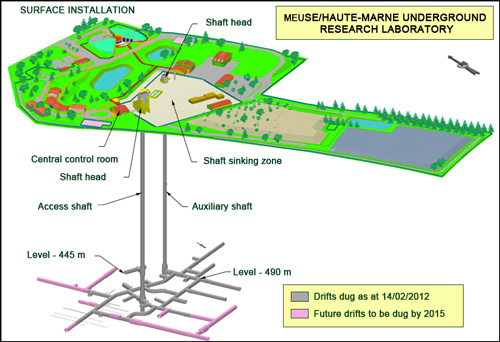Research into deep geological disposal

Cutaway view of the Bure laboratory
Since granite was abandoned, France has focussed its research on clay for a disposal facility. The tunnels of the underground Bure laboratory, on the boundary between Meuse and Haute-Marne, were dug in 2004-2005 from a main shaft. They are situated at depths of 445 m and 490 m in a Callovo-Oxfordian argillite layer, a medium that still holds fossil water dating from the Paris Basin formation. The laboratory studies chemical reactions, mechanical effects, water circulation that could bring radioelements back up to the surface.
© ANDRA
Can the nuclear industry’s final waste, which we currently do not know how to reuse, be safely buried deep underground? In what kind of ground can this type of disposal be considered? How can we be sure that it will be safe for very long periods of time?
These are the kinds of questions being asked about deep geological disposal, which is considered by the IAEA and many countries – Belgium, Finland, Germany, Sweden, Switzerland and the US – to be the safest method of managing radioactive waste. It involves using an underground layer of rock, such as clay, granite, salt or tuff, as a ‘safe’, or at least a means of holding back this waste, for vitrified waste packages or for spent fuel assemblies.
To answer the questions being asked, in December 1998 the French government decided to build two underground laboratories to study the disposal of high-level and intermediate-level waste, one in the clay of the Paris basin (at Bure in Haute-Marne) and the other in granite.
Testing is being done at these laboratories prior to any decision being made about disposal. The main aim of the research is to ensure that long-lived radioactive nuclei do not return to the biosphere. The migration distances and the lengths of time to be taken into account, for the buried atoms that must be prevented from returning to the living world, are such that it is necessary to use experiments and models in order to make sure that there will not be any risk even in the distant future.
The research also aims to find out how long a disposal facility of this kind could be reversible. If by chance our descendants discovered a way of using the waste, or making it disappear, could we be sure they were able to remove it from the disposal facility?
For research area 2 under the Bataille Act and for the research being carried out by ANDRA, a laboratory has been built at the Bure site in Haute-Marne to test clay as a medium. The boring of the shafts began in December 2000. France now has facilities at this site where the necessary research can be carried out.
Plans to build a laboratory in granite in Haute-Vienne have been abandoned because of opposition from local communities. Mission Granite, set up in February 2000, stopped work ‘pending further instructions’. The abandonment of this option prompted ANDRA to step up its collaboration with other countries engaged in this research (Sweden, Finland, Canada, etc.).
The results obtained have led to clay being chosen as a suitable environment for the site of a future French waste disposal facility. The 2006 Act sets out the conditions for installing a reversible waste disposal site in a deep geological stratum, which will be chosen in 2015. Waste could start being placed in it from 2025.
ANDRA video in french Tour of the Bure underground laboratory :
Until the final decision on the disposal facility site is made, research at the Bure underground laboratory will continue in order to finish demonstrating the containment properties of clay, clarify the engineering concepts, and scale up the research from the laboratory to a large waste disposal facility.
MORE : Results on underground disposal in clay
Other articles on the subject « Waste Outlooks »
Three research areas
Three complementary research areas The three research areas under the Bataille Act, later supplem[...]
Area 1: Partitioning
Sorting the radioelements in radioactive waste The separation, or partitioning, of the radioactiv[...]
Partitioning: results
Development of processes and extractant molecules The 2006 assessment of research into partitioni[...]
Advanced partitioning
Partitioning of nuclear waste: hot chemistry Advanced partitioning goes beyond just the partition[...]
Area 1: Transmutation
Area 1: Transmuting or transforming radioactive atoms Transmutation is the second part of researc[...]
Transmutation facilities
Fast reactors and Accelerator Driven Systems (ADS) The neutron, which easily penetrates nuclei, i[...]
Transmutation prospects
A far away objective for Generation IV and 2040… At the time of the first tests on the tran[...]
Area 3: Long Surface Storage
Research into long-term storage Research into long-term storage is the second research topic in a[...]
Long surface storage concepts
Long-term surface and subsurface storage Research into very long-term storage is a matter for the[...]
Area 3: Conditioning
Area 3: Research into conditioning The conditioning of high-level and intermediate-level waste is[...]